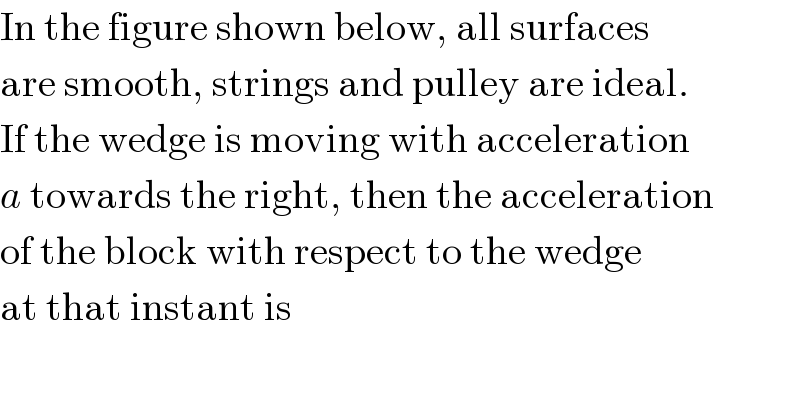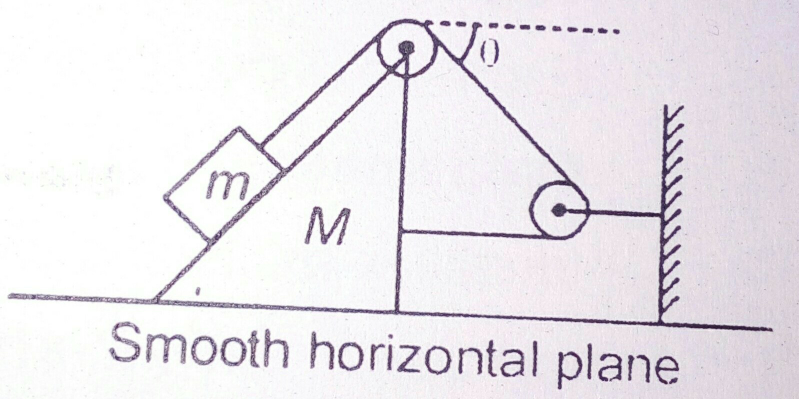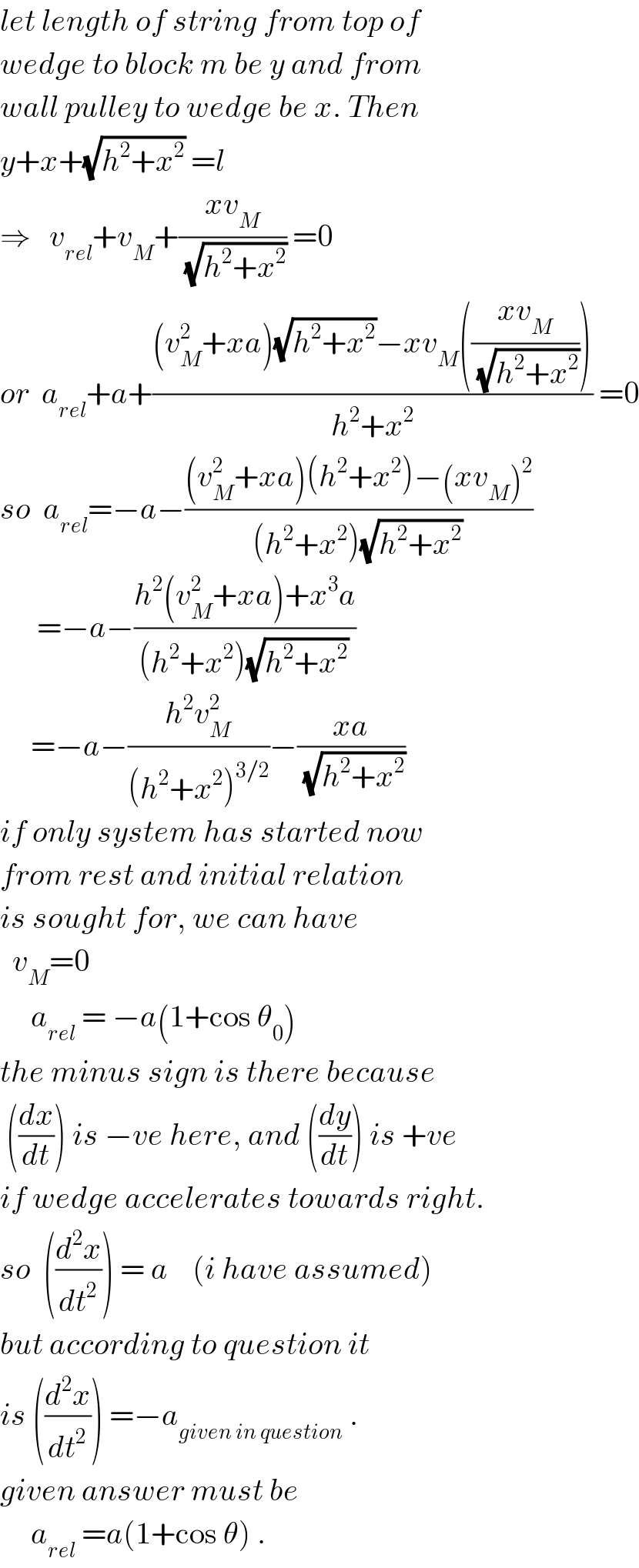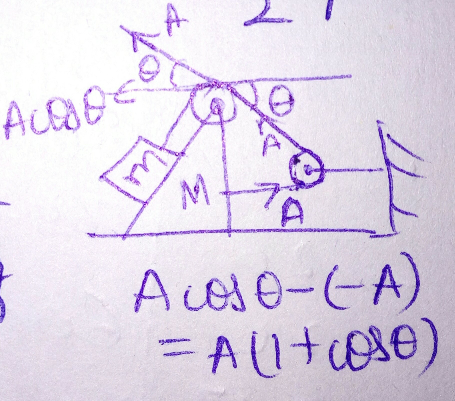
Question Number 24301 by Tinkutara last updated on 15/Nov/17

$$\mathrm{In}\:\mathrm{the}\:\mathrm{figure}\:\mathrm{shown}\:\mathrm{below},\:\mathrm{all}\:\mathrm{surfaces} \\ $$$$\mathrm{are}\:\mathrm{smooth},\:\mathrm{strings}\:\mathrm{and}\:\mathrm{pulley}\:\mathrm{are}\:\mathrm{ideal}. \\ $$$$\mathrm{If}\:\mathrm{the}\:\mathrm{wedge}\:\mathrm{is}\:\mathrm{moving}\:\mathrm{with}\:\mathrm{acceleration} \\ $$$${a}\:\mathrm{towards}\:\mathrm{the}\:\mathrm{right},\:\mathrm{then}\:\mathrm{the}\:\mathrm{acceleration} \\ $$$$\mathrm{of}\:\mathrm{the}\:\mathrm{block}\:\mathrm{with}\:\mathrm{respect}\:\mathrm{to}\:\mathrm{the}\:\mathrm{wedge} \\ $$$$\mathrm{at}\:\mathrm{that}\:\mathrm{instant}\:\mathrm{is} \\ $$
Commented by Tinkutara last updated on 15/Nov/17

Commented by ajfour last updated on 15/Nov/17

$${let}\:{length}\:{of}\:{string}\:{from}\:{top}\:{of} \\ $$$${wedge}\:{to}\:{block}\:{m}\:{be}\:{y}\:{and}\:{from} \\ $$$${wall}\:{pulley}\:{to}\:{wedge}\:{be}\:{x}.\:{Then} \\ $$$${y}+{x}+\sqrt{{h}^{\mathrm{2}} +{x}^{\mathrm{2}} }\:={l} \\ $$$$\Rightarrow\:\:\:{v}_{{rel}} +{v}_{{M}} +\frac{{xv}_{{M}} }{\sqrt{{h}^{\mathrm{2}} +{x}^{\mathrm{2}} }}\:=\mathrm{0} \\ $$$${or}\:\:{a}_{{rel}} +{a}+\frac{\left({v}_{{M}} ^{\mathrm{2}} +{xa}\right)\sqrt{{h}^{\mathrm{2}} +{x}^{\mathrm{2}} }−{xv}_{{M}} \left(\frac{{xv}_{{M}} }{\sqrt{{h}^{\mathrm{2}} +{x}^{\mathrm{2}} }}\right)}{{h}^{\mathrm{2}} +{x}^{\mathrm{2}} }\:=\mathrm{0} \\ $$$${so}\:\:{a}_{{rel}} =−{a}−\frac{\left({v}_{{M}} ^{\mathrm{2}} +{xa}\right)\left({h}^{\mathrm{2}} +{x}^{\mathrm{2}} \right)−\left({xv}_{{M}} \right)^{\mathrm{2}} }{\left({h}^{\mathrm{2}} +{x}^{\mathrm{2}} \right)\sqrt{{h}^{\mathrm{2}} +{x}^{\mathrm{2}} }} \\ $$$$\:\:\:\:\:\:=−{a}−\frac{{h}^{\mathrm{2}} \left({v}_{{M}} ^{\mathrm{2}} +{xa}\right)+{x}^{\mathrm{3}} {a}}{\left({h}^{\mathrm{2}} +{x}^{\mathrm{2}} \right)\sqrt{{h}^{\mathrm{2}} +{x}^{\mathrm{2}} }} \\ $$$$\:\:\:\:\:=−{a}−\frac{{h}^{\mathrm{2}} {v}_{{M}} ^{\mathrm{2}} }{\left({h}^{\mathrm{2}} +{x}^{\mathrm{2}} \right)^{\mathrm{3}/\mathrm{2}} }−\frac{{xa}}{\sqrt{{h}^{\mathrm{2}} +{x}^{\mathrm{2}} }} \\ $$$${if}\:{only}\:{system}\:{has}\:{started}\:{now} \\ $$$${from}\:{rest}\:{and}\:{initial}\:{relation} \\ $$$${is}\:{sought}\:{for},\:{we}\:{can}\:{have} \\ $$$$\:\:{v}_{{M}} =\mathrm{0} \\ $$$$\:\:\:\:\:{a}_{{rel}} \:=\:−{a}\left(\mathrm{1}+\mathrm{cos}\:\theta_{\mathrm{0}} \right) \\ $$$${the}\:{minus}\:{sign}\:{is}\:{there}\:{because} \\ $$$$\:\left(\frac{{dx}}{{dt}}\right)\:{is}\:−{ve}\:{here},\:{and}\:\left(\frac{{dy}}{{dt}}\right)\:{is}\:+{ve} \\ $$$${if}\:{wedge}\:{accelerates}\:{towards}\:{right}. \\ $$$${so}\:\:\left(\frac{{d}^{\mathrm{2}} {x}}{{dt}^{\mathrm{2}} }\right)\:=\:{a}\:\:\:\:\left({i}\:{have}\:{assumed}\right) \\ $$$${but}\:{according}\:{to}\:{question}\:{it} \\ $$$${is}\:\left(\frac{{d}^{\mathrm{2}} {x}}{{dt}^{\mathrm{2}} }\right)\:=−{a}_{{given}\:{in}\:{question}} \:. \\ $$$${given}\:{answer}\:{must}\:{be}\: \\ $$$$\:\:\:\:\:{a}_{{rel}} \:={a}\left(\mathrm{1}+\mathrm{cos}\:\theta\right)\:. \\ $$
Commented by Tinkutara last updated on 15/Nov/17

$$\mathrm{Thank}\:\mathrm{you}\:\mathrm{very}\:\mathrm{much}\:\mathrm{Sir}! \\ $$$$\mathrm{Your}\:\mathrm{solution}\:\mathrm{is}\:\mathrm{right}. \\ $$
Commented by Tinkutara last updated on 15/Nov/17

